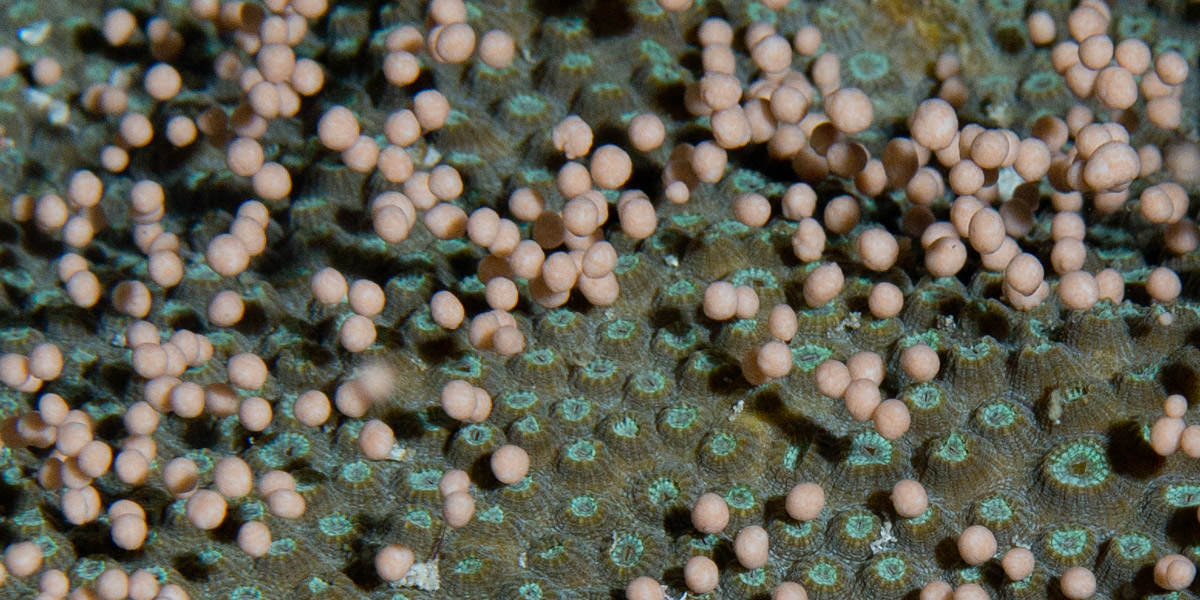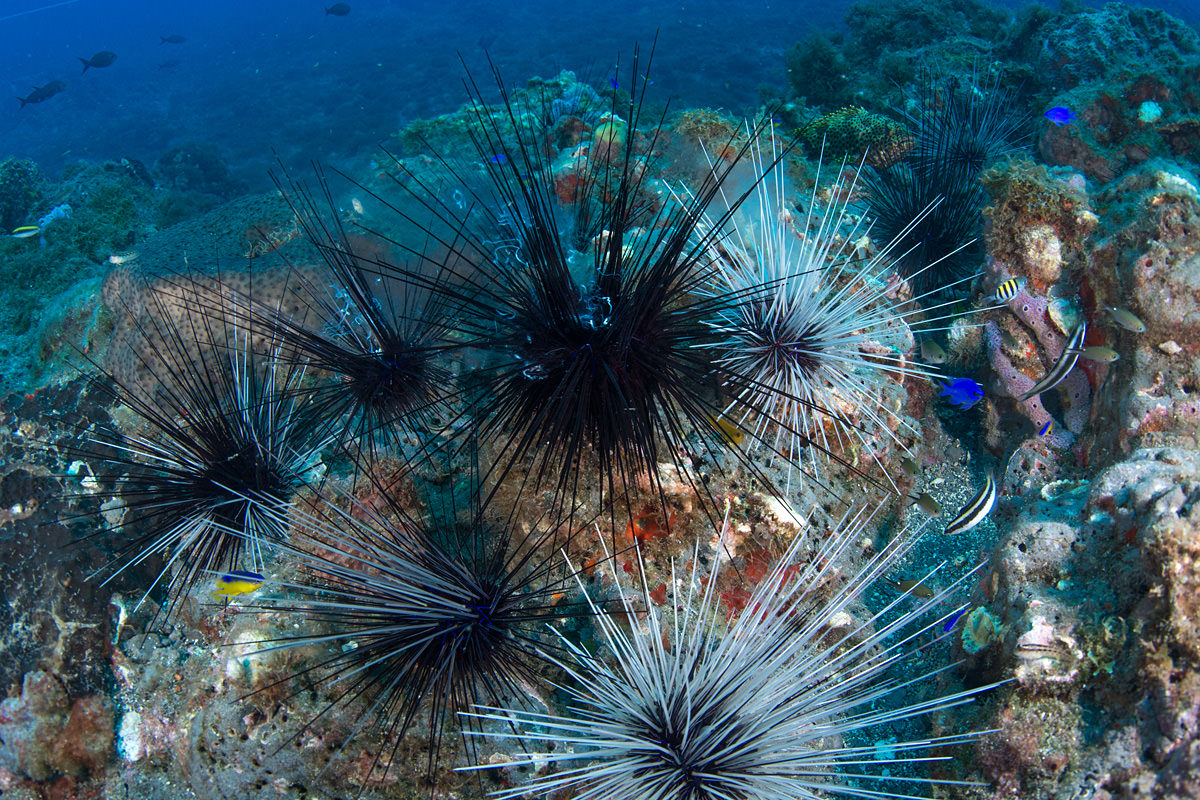Wildlife Health
Flower Garden Banks

Why is it a concern?
For “key” species in marine sanctuaries (e.g., keystone species, foundation species, indicator species, and other focal species), measures of condition and health can be important in determining the likelihood that these species will persist or recover and continue to provide vital ecosystem functions and services.
Corals are a “key” species on the coral cap at Flower Garden Banks National Marine Sanctuary (FGBNMS) because their structures create habitat for a diverse assemblage of reef organisms. The health of coral reef organisms within the sanctuary is measured in a number of ways. Coral growth is measured in coral cores from East and West Flower Garden Banks as part of the long-term monitoring efforts. Long-term monitoring projects at all three banks have been developed to provide data for the ongoing assessment of reef health. Indices include percent cover, dominance, and density of fish, lobster, and diadema (sea urchins).
Coral spawning at FGBNMS is likely one of the most prolific and predictable events in the Caribbean, but has not been quantified, and studies have not provided evidence for successful levels of recruitment locally.
Coral disease and bleaching is also monitored within the sanctuary. The health of other focal species is generally assessed through levels of abundance. Sea turtles and manta rays appear consistently in the sanctuary, but in varying numbers each year. Anecdotal reports suggest that the abundance of hammerhead sharks, grouper, snapper and jacks have been declining for the last decade or so. This is likely due to fishing pressure in the region. Aggregations of fish species are anecdotally reported but understudied and the locations and persistence have not been identified to provide a basis for protection.
Long-spined sea urchins (Diadema antillarum), which many consider an important keystone species on Caribbean reefs, experienced almost complete mortality at FGBNMS in 1983-84, as they did throughout the Caribbean basin. To date they remain in low abundance at East and West Flower Garden Banks, although they are showing a slight increase in density at the West Flower Garden Bank. Stetson Bank, though not quantified, appears to have a healthier population of Diadema. Aggregations of 30 or more are encountered regularly at the site.
Overview of Research
| Project Name | PI and contacts | Links |
|---|---|---|
East and West Flower Garden Banks Long-Term Monitoring |
Dr. Michelle Johnston, FGBNMS |
|
Stetson Bank Long Term Monitoring |
Marissa Nuttall, FGBNMS |
|
NCCOS three-year baseline study |
Randy Clark, NOAA-NCCOS |
|
National Coral Reef Monitoring Program |
Randy Clark, NOAA-NCCOS |
Science Needs and Questions
- What are the baseline heavy metal levels of key species?
- What is the importance of FGBNMS habitats for aggregating hammerhead sharks, spotted eagle rays, spinner sharks, and pelagic species such as manta rays, tiger sharks, whale sharks.
- Where and when are aggregations of fish species occurring? Why are they aggregating?
- What are the movements of pelagic species. Are our populations protected from injury and mortality throughout their range? What are the pressures on these populations throughout their ranges?
- What is the quantity of gametic material released during the masscoral spawning event?
- What is the prevalence, cause, and type of coral disease present in the sanctuary?
- What is the prevalence, cause, and type of sponge disease present in the sanctuary?
- What is the prevalence, cause, and type of fish diseases present in the sanctuary?
- Mesophotic species reproduction?
- What is the rate of coral recruitment?
- What is the rate of fish recruitment?
- What is the population of Diadema at Stetson Bank?
- What factors affect the abundance and distribution of Diadema in FGBNMS?
- What impact will ocean acidification and sea surface temperature variability have on keystone species at FGBNMS?
- What is the habitat use of keystone species (tracking studies)
- What impact does noise have on keystone species at FGBNMS?
- What impact does the invasion of lionfish have on keystone species at FGBNMS?
Education and Outreach Material
Coral Spawning Globe (224kb pdf)
- A reverse snow globe activity that models coral spawning on the reef. The resulting model has plastic pellets floating to the surface much like coral egg bundles.
Coral Cores: Ocean Timelines (6MB pdf)
- A lesson that explains how corals create their calcium carbonate skeletons in layers and what those layers can tell us. Includes x-ray images of actual coral cores taken from the sanctuary.
Secrets of the Gulf Activity 3: Coral Construction (2.7MB pdf)
- An Immersion Presents activity that models the beginnings of reef formation and the challenges of coral polyp settlement.
Reef Monitoring Lesson (636kb pdf)
- A lesson using observation skills to examine changes over time in a reef habitat. Requires a series of actual reef monitoring images that can be downloaded from the Stetson Bank Monitoring Images web page
Secrets of the Gulf Activity 5: Manta Mysteries (2.8MB pdf)
- An Immersion Presents activity that introduces the challenges of identifying and tracking manta rays. Can be supplemented with all of the manta catalog information available on this web site.

References
Baggett, L.S. 1985. Patterns of coral recruitment at the East Flower Garden bank. M.S. Thesis, Texas A&M University, College Station, Texas. 55 pp.
Continental Shelf Assoc., Inc. 1996. Long-term monitoring at the East and West Flower Garden Banks. OCS Study MMS 96-0046. U.S. Department of the Interior, Minerals Management Service, Gulf of Mexico OCS Region, New Orleans, Louisiana. 77 pp. + app
Davies S.W., Matz M.V., Vize P.D. (2013) Ecological Complexity of Coral Recruitment Processes: Effects of Invertebrate Herbivores on Coral Recruitment and Growth Depends Upon Substratum Properties and Coral Species. PLoS ONE 8(9): e72830.doi:10.1371/journal.pone.0072830
Dokken, Q.R., I.R. MacDonald, J.W. Tunnell, Jr., C.R. Beaver, G.S. Boland, and D.K. Hagman. 1999. Long-term monitoring at the East and West Flower Garden Banks, 1996-1997. U.S. Department of the Interior, Minerals Management Service, Gulf of Mexico OCS Region, New Orleans, Louisiana. OCS Study MMS99-0005.
Dokken, Q.R., I.R. MacDonald, J.W. Tunnell, Jr., T. Wade, K. Withers, S.J. Dilworth, T.W. Bates, C.R. Beaver, and C.M. Rigaud. 2003. Long-term monitoring at the East and West Flower Garden Banks, 1998-2001: Final Report. U.S. Department of the Interior, Minerals Management Service, Gulf of Mexico OCS Region, New Orleans, Louisiana. OCS Study MMS 2003-031. 90 pp.
Gittings, S.R. and G.S. Boland. 1991. Long-term monitoring on the Flower Garden Banks: study design and field methods. pp. 24-28 In: Proc.: Eleventh Ann. Gulf of Mexico Information Transfer Meeting. U.S. Department of the Interior, Minerals Management Service, New Orleans, Louisiana. Contract No. 14-35-0001-30499. OCS Study MMS-91-0040. 524 pp.
Gittings, S.R., G.S. Boland, K.J.P. Deslarzes, D.K. Hagman and B.S. Holland. 1992b. Long-term monitoring at the East and West Flower Garden Banks. Final Rept. OCS Study/MMS 92-006. U.S. Department of the Interior, Minerals Management Service, Gulf of Mexico OCS Regional Office, New Orleans, Louisiana. 206 pp.
Hagman, D.K. 2001. Reproductive dynamics of coral reef biota at the Flower Gardens. Ph.D. Dissertation, University of Texas at Austin, Austin, Texas.
Johnston, Michelle A., M.F. Nuttall, R.J. Eckert, J.A. Embesi, N.C. Slowey, E.L. Hickerson, and G.P. Schmahl. 2013. Long-term monitoring at the East and West Flower Garden Banks National Marine Sanctuary, 2009–2010, volume 2: appendices. U.S. Dept. of Interior, Bureau of Ocean Energy Management, Gulf of Mexico OCS Region, New Orleans, Louisiana. OCS Study BOEM 2013-215. 362 pp.
Johnston, M.A., M.F. Nuttall, R.J. Eckert, J.A. Embesi, N.C. Slowey, E.L. Hickerson, and G.P. Schmahl. 2015. Long-term monitoring at East and West Flower Garden Banks National Marine Sanctuary, 2011–2012, volume 1: technical report. U.S. Dept. of Interior, Bureau of Ocean Energy Management, Gulf of Mexico OCS Region, New Orleans, Louisiana. OCS Study BOEM 2015-027. 194 p.
Precht W.F., R.B. Aronson, K.J.P. Deslarzes, M.L. Robbart, T.J.T. Murdoch, A. Gelber, D. Evans, B. Gearheart and B. Zimmer. 2010. Long-term monitoring at the East and West Flower Garden Banks, 2004-2005; Final report. U.S. Department of the Interior, Minerals Management Service, Gulf of Mexico OCS Region, New Orleans, Louisiana. OCS Study MMS.
Snell, T.L., D.W. Foltz and P.W. Sammarco. 1998. Variation in Morphology vs. Conservation of a Mitochondrial Gene in Montastraea caver-nosa (Cnidaria, Scleractinia). Gulf of Mexico Science XVI No. 2:188.
Zimmer, B., L. Duncan, R.B. Aronson, K.J.P. Deslarzes, D. Deis, M. L. Robbart, W. F. Precht, L. Kaufman, B. Shank, E. Weil, J. Field, D.J. Evans, and L. Whaylen. 2011. Long-term monitoring at the East and West Flower Garden Banks, 2004-2008. Volume I: Technical report. U.S. Dept. of the Interior, Bureau of Ocean Energy Management, Regulation, and Enforcement, Gulf of Mexico OCS Region, New Orleans, Louisiana. OCS Study BOEMRE 2010-052. 310pp.

